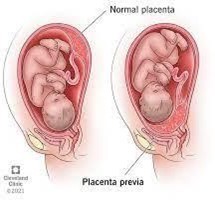A nurse is caring for an infant who has gastroesophageal reflux. The nurse should place the infant in which of the following positions after feeding?
Prone
Upright
Right side
Left side
The Correct Answer is B
Choice A rationale: Placing the infant in the prone position (face down) after feeding is not recommended for a baby with gastroesophageal reflux. The prone position can increase the risk of aspiration if reflux occurs while the baby is lying down.
Choice B rationale: For an infant with gastroesophageal reflux, placing the baby in an upright position after feeding can help prevent or reduce reflux episodes. Keeping the infant in an upright position allows gravity to assist in keeping stomach contents down and reduces the likelihood of reflux into the esophagus.
Choice C rationale: Placing the infant on the right side after feeding is also not recommended for managing gastroesophageal reflux. The right side position may not be as effective in preventing reflux as the upright position.
Choice D rationale: Placing the baby on either side after feeding is also not recommended for managing gastroesophageal reflux. The upright position is more effective in preventing reflux episodes and promoting digestion. Side-lying positions after feeding may not provide the same benefits and can potentially increase the risk of reflux.
Nursing Test Bank
Naxlex Comprehensive Predictor Exams
Related Questions
Correct Answer is D
Explanation
Choice A rationale: Applying ice to the perineal area is not indicated in the case of suspected placenta previa. Placenta previa is related to the location of the placenta in the uterus and is not affected by the perineal area. Ice is commonly used for perineal discomfort after vaginal delivery but is not appropriate for placenta previa.
Choice B rationale: When a client is suspected to have placenta previa, a vaginal exam should be avoided because it can cause trauma to the placenta, leading to significant bleeding. Placenta previa is a condition where the placenta covers part or all of the cervix, and any disruption of the placenta can result in bleeding, which poses a risk to both the mother and the baby. Therefore, a vaginal exam is contraindicated in this situation.
Choice C rationale: Performing a rectal exam is also not appropriate for a client with suspected placenta previa. Rectal exams do not provide any relevant information about the placenta's location, and they can potentially cause discomfort or bleeding in this situation.
Choice D rationale: Applying an external fetal monitor is an appropriate action when caring for a pregnant client, regardless of whether there is a suspected placenta previa. The external fetal monitor is used to assess the baby's heart rate and uterine contractions and is a routine part of prenatal care. However, it does not specifically address the issue of placenta previa. The nurse should be vigilant for any signs of bleeding or changes in fetal heart rate pattern, which may indicate placental issues, and report them promptly for further evaluation and management.

Correct Answer is D
Explanation
Choice A rationale: Applying identification bands is an essential step in newborn care, but it is not the priority immediately after delivery. The nurse should first address the baby's physiological needs, such as drying and maintaining body temperature.
Choice B rationale: Assessing and documenting the Apgar score is important for evaluating the newborn's overall condition and response to delivery, but it is not the priority immediately after delivery.
Choice C rationale: Administering phytonadione (vitamin K) to prevent bleeding disorders in the newborn is essential, but it can be done after drying and stabilizing the baby's body temperature.
Choice D rationale: After ensuring a patent airway, the nurse's priority should be to dry the newborn. Drying the newborn is important for maintaining body temperature and preventing heat loss, especially during the immediate post-delivery period. Wet newborns can lose heat rapidly through evaporation, so drying the baby helps prevent hypothermia and stabilize the baby's body temperature.
Whether you are a student looking to ace your exams or a practicing nurse seeking to enhance your expertise , our nursing education contents will empower you with the confidence and competence to make a difference in the lives of patients and become a respected leader in the healthcare field.
Visit Naxlex, invest in your future and unlock endless possibilities with our unparalleled nursing education contents today
Report Wrong Answer on the Current Question
Do you disagree with the answer? If yes, what is your expected answer? Explain.
Kindly be descriptive with the issue you are facing.
